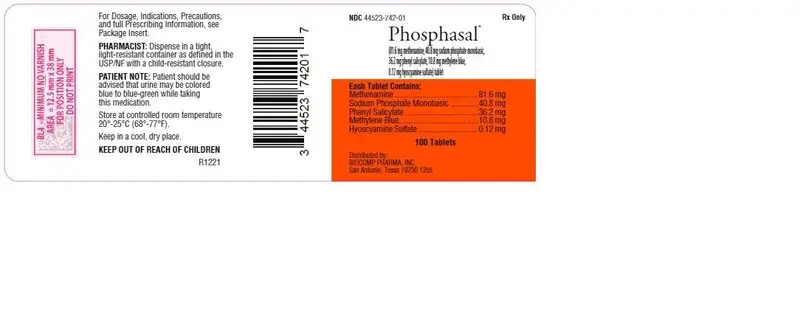Drug Class: Urinary antispasmodics
Phosphasal Description
Phosphasal ® tablets for oral administration
| Each tablet contains: | |
| Methenamine | 81.6 mg |
| Sodium Phosphate Monobasic | 40.8 mg |
| Phenyl Salicylate | 36.2 mg |
| Methylene Blue | 10.8 mg |
| Hyoscyamine Sulfate | 0.12 mg |
HYOSCYAMINE SULFATE. [620-61-1][3(S)-endo]-α-(Hydroxymethyl)-benzeneacetic acid 8-methyl-8-azabicyclo[3.2.1]oct-3-yl ester sulfate(2:1)(salt); 1αH,5αH-tropan-3α-ol(-)-tropate(ester) sulfate(2:1)(salt);3α-tropanyl S-(-)-tropate; l-tropic acid ester with tropine; l-tropine tropate. C 34H 48N 2O 10S. Hyoscyamine Sulfate is an alkaloid of belladonna. Exists as a white crystalline powder. Its solutions are alkaline to litmus. Affected by light, it is slightly soluble in water; freely soluble in alcohol; sparingly soluble in ether.
METHENAMINE. [100-97-0] 1,3,5,7-Tetraazatricyclo [3.3.1.-1 3,7] decane; hexamethylenetetramine; HMT; HMTA; hexamine; 1,3,5,7-tetraazaadamantane hexamethylenemine; Uritone; Urotropin. C 6H 12N 4; mol wt 140.19; C 51.40%, H 8.63%, N 39.96%. Methenamine (hexamethylenetetramine) exists as colorless, lustrous crystals or white crystalline powder. Its solutions are alkaline to litmus. Freely soluble in water, soluble in alcohol and in chloroform.
METHYLENE BLUE. [61-73-4] 3,7-Bis(dimethylamino) phenothiazin-5-ium chloride; C.I. Basic Blue 9; methylthioninium chloride; tetramethylthionine chloride; 3,7-bis(dimethylamino) phenazathionium chloride. C 16H 18ClN 3S; mol wt 319.85, C 60.08%, H 5.67%, Cl 11.08%, N 13.14%, S 10.03%. Methylene Blue (Methylthionine chloride) exists as dark green crystals. It is soluble in water and in chloroform; sparingly soluble in alcohol.
PHENYL SALICYLATE. [118-55-8] 2-Hydroxybenzoic acid phenyl ester; Salol. C 13H 10O 3; mol wt 214.22, C 72.89%, H 4.71%, O 22.41%. Made by the action of phosphorus oxy-chloride on a mixture of phenol and salicylic acid. Phenyl Salicylate exists as white crystals with a melting point of 41°-43° C. It is very slightly soluble in water and freely soluble in alcohol.
SODIUM PHOSPHATE MONOBASIC. [7558-80-7] Phosphoric acid sodium salt (1:1); Sodium biphosphate; sodium dihydrogen phosphate; acid sodium phosphate; monosodium orthophosphate; primary sodium phosphate; H 2NaO 4P; mol wt 119.98, H 1.68%, Na 19.16%, O 53.34%, P 25.82%. Monohydrate, white, odorless slightly deliquesce crystals or granules. At 100° C loses all its water; when ignited it converts to metaphosphate. It is freely soluble in water and practically insoluble in alcohol. The aqueous solution is acid. pH of 0.1 molar aqueous solution at 25° C: 4.5.
Phosphasal ® tablets contain inactive ingredients: Crospovidone, Dicalcium Phosphate, FD&C Blue #1 Aluminum Lake, Magnesium Stearate, Microcrystalline Cellulose, Polyethylene Glycol, Polyvinyl Alcohol, Stearic Acid, Talc, and Titanium Dioxide.
Indications and Usage for Phosphasal
Phosphasal ® tablets are indicated for the treatment of symptoms of irritative voiding. Indicated for the relief of local symptoms, such as inflammation, hypermotility, and pain, which accompany lower urinary tract infections. Indicated for the relief of urinary tract symptoms caused by diagnostic procedures.
Precautions
Pregnancy/Reproduction
FDA Pregnancy Category C
hyoscyamine and methenamine cross the placenta. Studies concerning the effect of hyoscyamine and methenamine on pregnancy and reproduction have not been done in animals or humans. Thus it is not known whether Phosphasal ® tablets cause fetal harm when administered to a pregnant woman or can affect reproduction capacity and should be given to a pregnant woman only if clearly needed.
Adverse Reactions/Side Effects
Cardiovascular: rapid heartbeat, flushing
Central Nervous System: blurred vision, dizziness, drowsiness
Genitourinary: difficult micturition, acute urinary retention
Gastrointestinal: dry mouth, nausea and vomiting
Respiratory: shortness of breath or trouble breathing
Serious allergic reactions to this drug are rare. Seek immediate medical attention if you notice symptoms of a serious allergic reaction, including itching, rash, severe dizziness, swelling or trouble breathing.
This medication can cause urine and sometimes stools to turn blue to blue-green. This effect is harmless and will subside after medication is stopped.
Call your doctor or physician for medical advice about side effects. To report SUSPECTED ADVERSE REACTIONS, contact BioComp Pharma at 1-866-762-2365 or FDA at 1-800-FDA-1088, www.fda.gov/medwatch.
Drug interactions
As a result of hyoscyamine's effects on gastrointestinal motility and gastric emptying, absorption of other oral medications may be decreased during concurrent use with this combination medication. Methylene blue inhibits a range of CYP isozymes in vitro, including 1A2, 2B6, 2C8, 2C9, 2C19, 2D6 and 3A4/5. This interaction could be more pronounced with narrow therapeutic index drugs that are metabolized by one of these enzymes (e.g., digoxin, warfarin, phenytoin, alfentanil, cyclosporine, dihydroergotamine, ergotamine, fentanyl, pimozide, quinidine, sirolimus and tacrolimus). However, the clinical relevance of these in vitro interactions is unknown.
Drug Abuse and Dependence
A dependence on the use of Phosphasal ® tablets has not been reported and due to the nature of its ingredients, abuse of Phosphasal ® tablets is not expected.
| PHOSPHASAL
methenamine, sodium phosphate, monobasic, monohydrate, phenyl salicylate, methylene blue, and hyoscyamine sulfate tablet |
||||||||||||||||||||||||
|
||||||||||||||||||||||||
|
||||||||||||||||||||||||
|
||||||||||||||||||||||||
|
||||||||||||||||||||||||
|
||||||||||||||||||||||||
|
||||||||||||||||||||||||
| Labeler - BioComp Pharma (829249718) |





